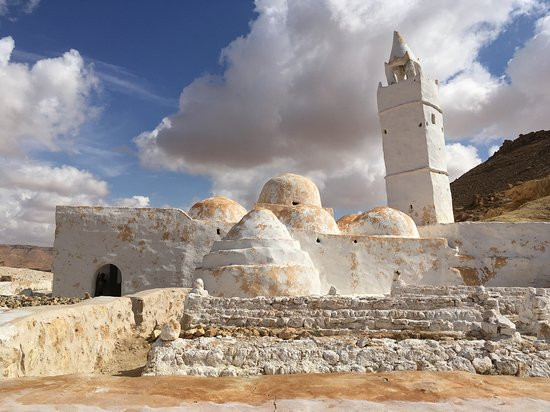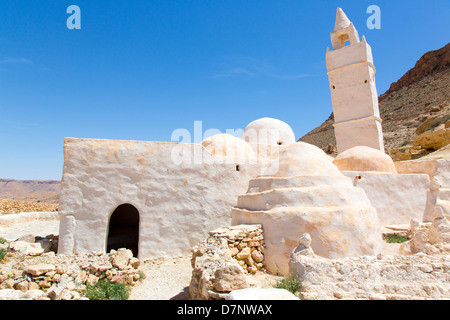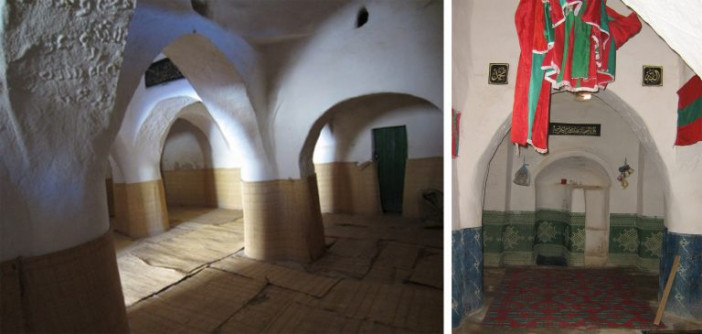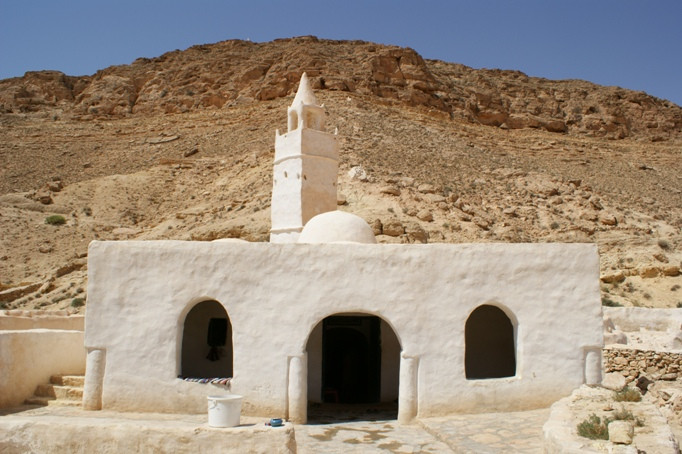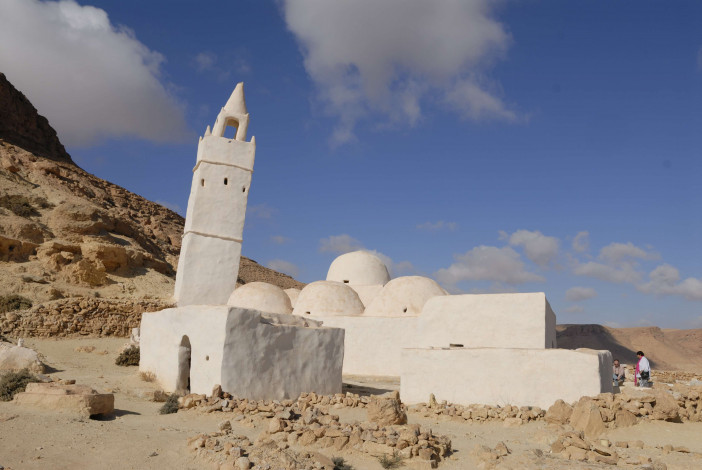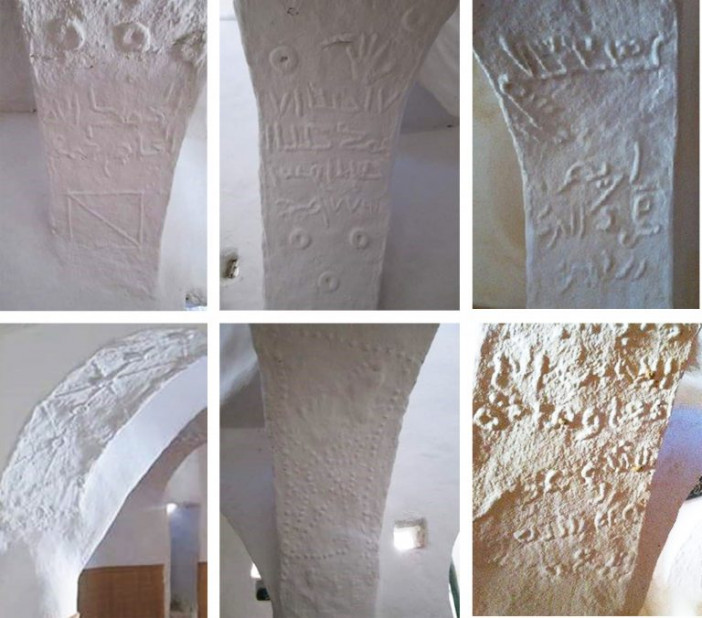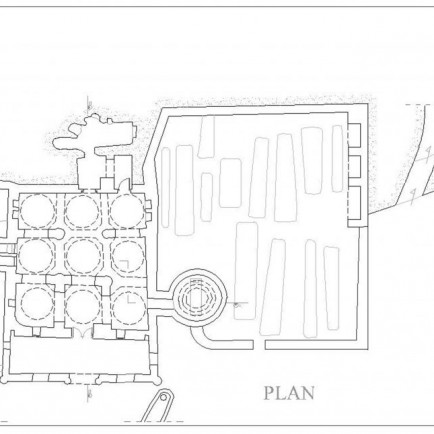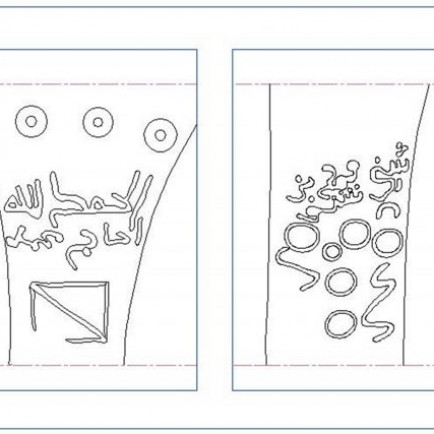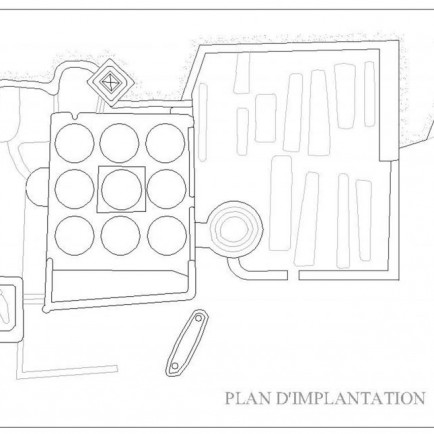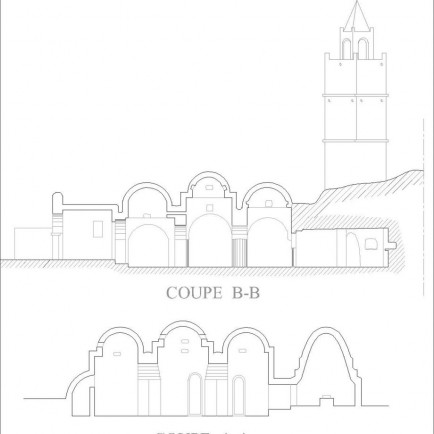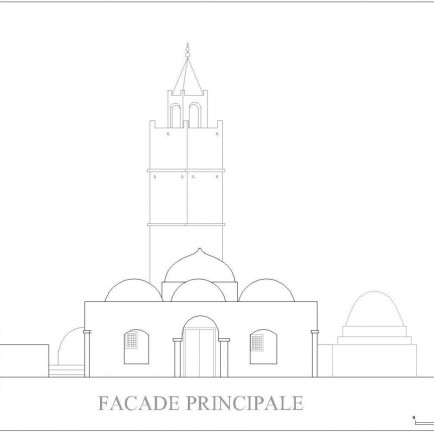Mosque of the Seven Sleepers in Chenini-Tataouine
History
Epigraphic decorations, of the vernacular type, are also present. The terms Chenini, Allah, Mohamed are mentioned there. Sometimes, the names of people who have probably undertaken construction, restoration or financing campaigns (al-Hadj Mohamed, 'Ali, etc.) are mentioned. Some actions have also been dated. As an example, we mention the date of 1321H
Urban and Architectural
With its white appearance that contrasts with the surrounding rocky landscape, the mosque stands out for its slightly sloping minaret and dome roof. It is nestled between two rocky blocks: a crest with some headstones and a small hill where we probably find pre-Islamic remains. There is a spring near the monument on a nearby mound.
The prayer room has a rather sober architectural decoration. There are quite irregular pillars, low arches, corbels, interplay of coatings...However, the bottom of the arches supporting the domes bear relatively rich decorations. These are made in high relief on a plaster-based coating. We perceive geometric designs such as points, lines, discs, rectangles, rhombuses… And quite frequently, figures of human hands and feet.
Description
Inside, the axis of the wall of the Qibla is smashed by a hollow 1.25 m deep, the upper part of which is formed by a cul-de-four with a low profile. The lower part of the niche is divided vertically into two side compartments separated by a low wall which reaches the level of the start of the arch. These recesses play the role of Mihrâb and of preaching pulpit with two steps or Minbar. This niche protrudes externally on the axis of the wall of the Qibla. At its northern corner, the prayer hall communicates with a funerary chamber with a circular plan. This is covered by a dome with a conical profile whose cap rests externally on two superimposed cylindrical drums. This space contains an elongated burial, covered with recently painted rubble.
On the west side, the prayer hall opens onto a cave dug into the hill in the form of a ghar. On this same rocky massif rises a minaret whose base is almost located at the height of the roof of the monument. This tower, slightly leaning towards the east, follows relatively the opposite inclination to that of the neighboring hill.
References
https://www.al-sabil.tn/?p=5059
Details
Location
Chenini, Tunisie
Worshippers
40
Owners
The Tunisian Government
Area
200
Drawings
Map
History
Epigraphic decorations, of the vernacular type, are also present. The terms Chenini, Allah, Mohamed are mentioned there. Sometimes, the names of people who have probably undertaken construction, restoration or financing campaigns (al-Hadj Mohamed, 'Ali, etc.) are mentioned. Some actions have also been dated. As an example, we mention the date of 1321H
Urban and Architectural
With its white appearance that contrasts with the surrounding rocky landscape, the mosque stands out for its slightly sloping minaret and dome roof. It is nestled between two rocky blocks: a crest with some headstones and a small hill where we probably find pre-Islamic remains. There is a spring near the monument on a nearby mound.
The prayer room has a rather sober architectural decoration. There are quite irregular pillars, low arches, corbels, interplay of coatings...However, the bottom of the arches supporting the domes bear relatively rich decorations. These are made in high relief on a plaster-based coating. We perceive geometric designs such as points, lines, discs, rectangles, rhombuses… And quite frequently, figures of human hands and feet.
Description
Inside, the axis of the wall of the Qibla is smashed by a hollow 1.25 m deep, the upper part of which is formed by a cul-de-four with a low profile. The lower part of the niche is divided vertically into two side compartments separated by a low wall which reaches the level of the start of the arch. These recesses play the role of Mihrâb and of preaching pulpit with two steps or Minbar. This niche protrudes externally on the axis of the wall of the Qibla. At its northern corner, the prayer hall communicates with a funerary chamber with a circular plan. This is covered by a dome with a conical profile whose cap rests externally on two superimposed cylindrical drums. This space contains an elongated burial, covered with recently painted rubble.
On the west side, the prayer hall opens onto a cave dug into the hill in the form of a ghar. On this same rocky massif rises a minaret whose base is almost located at the height of the roof of the monument. This tower, slightly leaning towards the east, follows relatively the opposite inclination to that of the neighboring hill.


